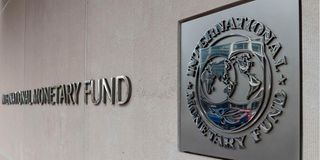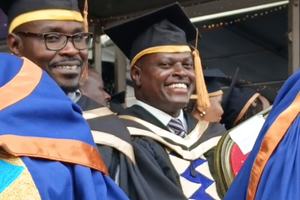Premium
Treasury taps new Sh20bn from IMF-backed CBK dollar reserve

This file photo taken on March 27, 2020, shows an exterior of the International Monetary Fund (IMF) Headquarters in Washington, DC.
The Treasury in the quarter that ended September this year tapped a fresh Sh20.3billion from the dollar reserves the Central Bank of Kenya(CBK) received from the International Monetary Fund(IMF) in form of special drawing rights(SDR) in August last year.
The latest budget review report by the Treasury confirmed the transaction, raising the total amount that the State has so far drawn from the CBK-held reserves this year to Sh61.17billion.
The SDR funds were allocated to Kenya as part of the multilateral lender’s bailout to all countries in the world — to ease the balance of payment constraints for Covid-19-hit economies.
In the SDR programme, Kenya received $740 million (Sh90.27billion), boosting its foreign reserves.
The Treasury in the quarter that ended June this year tapped Sh40.87billion from the SDR dollar reserves for budgetary support.
The State told the IMF in December that it targeted to utilise part of the funds locally and would borrow half of the SDR allocation from the CBK in local currency, which it would repay in 30 years.
Kenya is hard-pressed for cash to repay its rising debt obligations, pay public workers and undertake a retinue of development projects amid a biting hunger after drought ravaged large swathes of the country for months this year.
President William Ruto is also looking for cash to implement his ambitious campaign promises including the Sh50 billion Hustler Fund which is set to be launched on November 30 to give low-cost loans to individuals and businesses.
The government has however received a timely boost after the IMF last week approved a Sh52.7 billion loan to Kenya pending approval from its executive board.
The financing is part of the 38-month package approved in April 2021.
The programme is expected to end in April 2024. Kenya has so far received Sh188 billion ($1.5 billion) in credit from the lender.
IMF also said about 48 percent of the Sh52.7 billion loan will be used to cover external financing needs resulting from drought and challenging global financing conditions.
Mary Goodman and Tobias Rasmussen, the IMF’s heads of the delegation to Kenya said Kenya had made progress on addressing the fiscal challenges by cutting the budget deficit and with planned spending cuts by the new government.
Forceful measurements
“The authorities are taking forceful measures to further reduce the fiscal deficit. Fuel subsidies were mostly eliminated in September and the variable cost adjustments in electricity prices were reinstated.
"In addition, the new government is in the process of formulating a supplementary budget for financial year 2022/23 that will institute significant spending cuts with a view to modestly reducing the deficit from the previously programmed level of 5.9 percent of GDP while increasing allocations for drought interventions,” they said.
President Ruto last month announced a Sh300 billion cut to the Sh3.3 trillion budget for the financial year 2022/23 targeting non-essential items such as travel, entertainment, public relations budgets as well as civil servants allowances.





